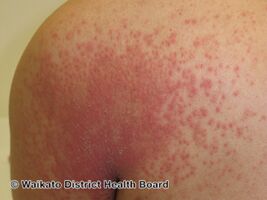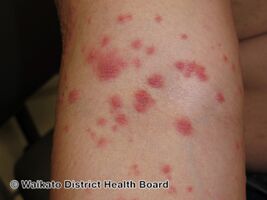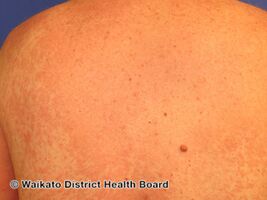Autoeczematization
Autoeczematization refers to the development of widespread dermatitis or dermatitis distant from a local inflammatory focus.[1]: 81 Autosensitization (autoeczematization or “id” reaction) refers to an acute, pruritic papulovesicular eruption that develops at cutaneous sites distant from a primary focus and is unrelated to the inciting cause of the primary inflammation.[2]
The pathogenesis is not fully understood. One hypothesis is that autoeczematization is due to hyperirritability of the skin induced by immunologic or nonimmunologic stimuli and mediated by epidermal cytokines. Histologic findings are nonspecific and include spongiosis and a dermal lymphohistiocytic infiltrate with eosinophils.[3]
-
Autoeczematization
-
Autoeczematization
-
Autoeczematization
See also
References
- ↑ James, William; Berger, Timothy; Elston, Dirk (2005). Andrews' Diseases of the Skin: Clinical Dermatology. (10th ed.). Saunders. ISBN 0-7216-2921-0.
- ↑ Belsito DV. Autosensitization dermatitis. In: Fitzpatrick's Dermatology in General Medicine, Seventh, Wolff K, Goldsmith Lowell A, Katz SI, et al. (Eds), McGraw Hill Medical, New York, NY 2008. Vol I, p.167.
- ↑ "Archive copy". Archived from the original on 2016-03-04. Retrieved 2020-05-13.
{{cite web}}: CS1 maint: archived copy as title (link)


